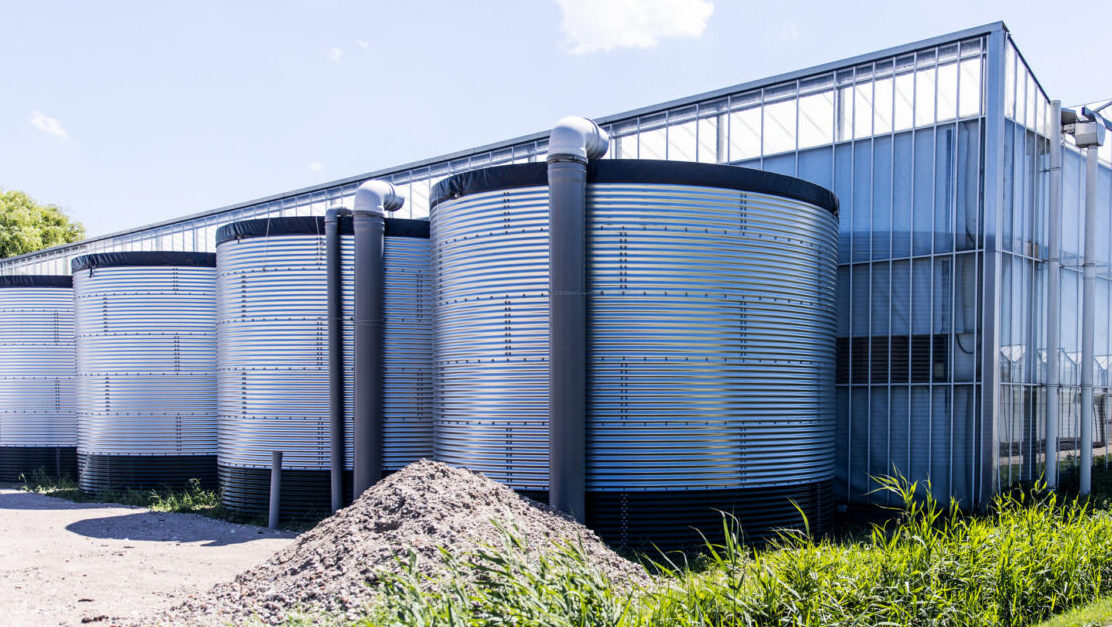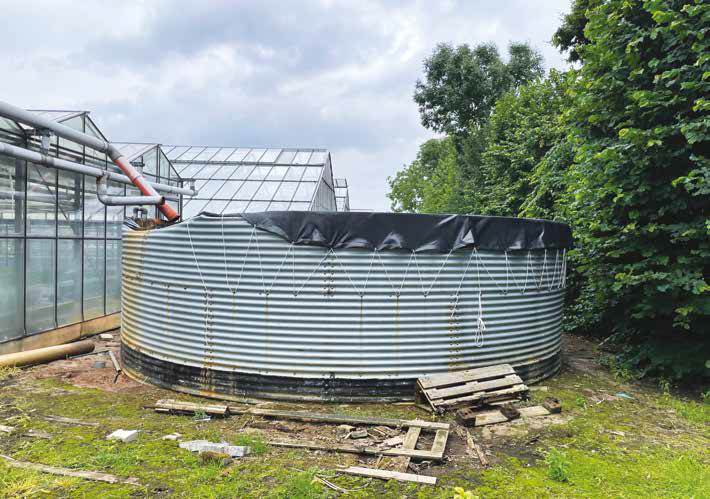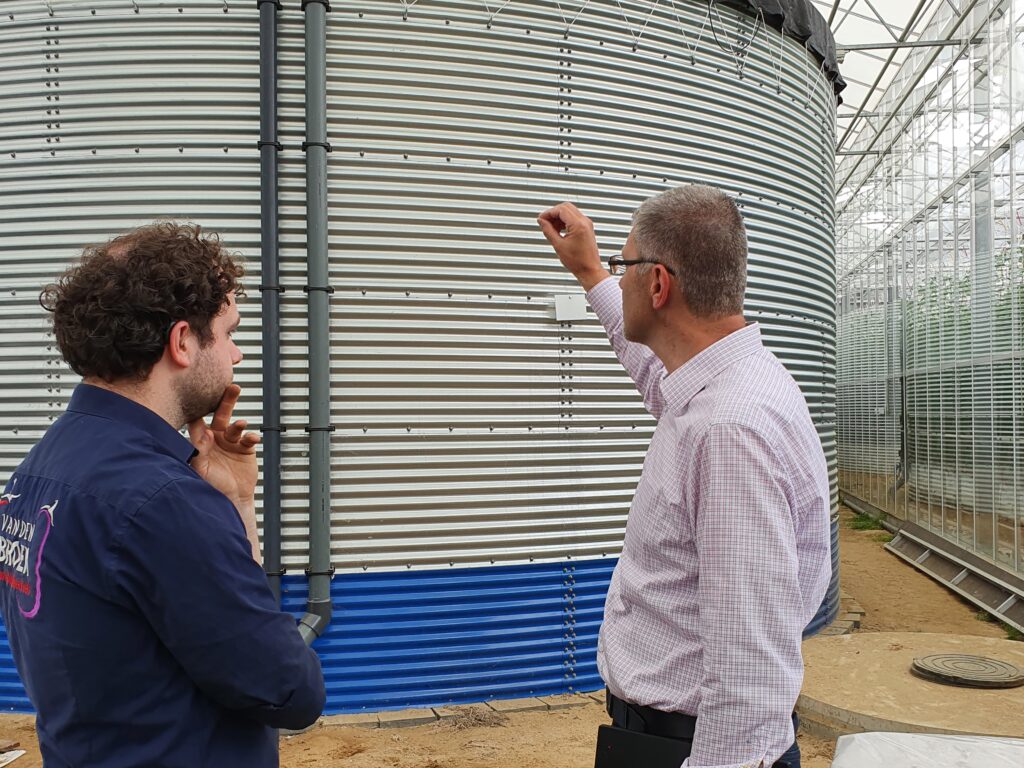
Planning, maintenance, early warning signs
In recent years, Gartenbau-Versicherung has received an increasing number of claims for burst water tanks. The damage to the tank itself is usually the least of the problems. Water tanks are still a relatively inexpensive solution for ensuring that water, a primary resource for horticulture, is reliably available even during dry periods.
Prevention is possible – and absolutely essential!
Bursting tanks cause enormous consequential damage. When more than 500 tons of water suddenly burst out of a tank at full force, the water masses can even destroy brick walls. Even heavy equipment such as boilers can be dislodged by the resulting forces, and expensive electronic parts can be completely destroyed. Often, standing walls and supports are also demolished, glass is shattered, there is damage to crops and extensive soiling – operations are severely disrupted or even halted completely. All this is much more expensive than the cost of the ruptured tank – not to mention the possible danger to people who may be in the vicinity at the time of the incident.
INCREASED SAFETY through GOOD PLANNING and professional construction
a) Tips on buying your tank:
Water tanks are statically designed to store as much water as possible while using as little material as possible. In other words, the thin silo walls are not optimized for a high degree of safety. Most tanks therefore have walls that are only 0.8 – 1.2 mm thick. This corresponds approximately to a stack of
10 pages of copy paper.
If possible, use “coated” tanks for your open-field cultivation!
Plastic coating increases corrosion resistance. This is especially the case when it comes to the consequences of unavoidable exposure to corrosive substances and moisture along the lowest ring.As supplier merchandise, water tanks are of course subject to standards and directives, whose technical requirements are designed to ensure safety. Nevertheless, there are variations in quality that should be taken into account. And of course not every water tank is suitable for every business and its requirements. So what do the specialists at Gartenbau-Versicherung recommend when it comes to making a purchase?
- Choose reputable, established suppliers or manufacturers!
- If possible, use “coated” tanks for your open-field cultivation!
- Be sure to also choose the inner foil / tank foil / container foil wisely!
b) The right location:
A suitable location will increase the durability of the silo while reducing the extent of consequential damage in the event of the tank bursting. The following recommendations can help you select the best location:
Zones with little “traffic” are most suitable
Ideally, the water tank should be located in the zone of the business with the least “traffic”. In parts of the business in which cars and machinery are moving around, water tanks should be protected by some form of impact cushioning, such as crash barriers, bollards or concrete obstacles. In addition, the area within a radius of 2 to 3 meters around the tank should not be used as a maneuvering or parking area. If goods are frequently stored and handled there, the likelihood of accidents and unintentional contact, e.g. by the forklift fork or falling parts, increases.
Avoid extreme temperature fluctuations
Extreme heat and cold as well as temperature fluctuations can damage and deform the steel plate of the tanks. This can lead to changes in shape and size, which can cause leaks, especially at overlap joints and screw connections.
Subsoil: Dry, stable, level
Filled water tanks weigh several tons per square meter. This exerts a great deal of pressure on the base area and can quickly cause the silo to subside on one side or deteriorate prematurely due to corrosion – especially if the foundation is not strong enough, the subsoil is not properly compacted or soil is eroded.
The latter occurs above ground, for example, through overflow water, and below ground through ground water or the decomposition of humus. N. B.: Tanks can only stand securely if the outer walls are exactly vertical!
Only the smallest of deviations can be tolerated.
c) Correct installation and initial operation
Before you begin
Silos must also meet certain standards and comply with certain guidelines in terms of their construction. Having the silos installed by specialist companies usually helps to rule out avoidable errors that could significantly reduce their durability. Liability and warranty also remain valid.
Installation
During the actual construction, the first most important thing is the preparation of the ground. For the tank to stand securely, you need either a sufficiently dimensioned, level base plate or a sand bed with concrete slabs to support the tank. The entire circumference of the container must fit on the slab(s) and be stable. Prior to installation, also take care of any piping that needs to go through the concrete slabs or sand bed.
Fastening the tank
It is important that the tank is securely fastened, as the shape of water tanks installed outdoors makes them particularly vulnerable to the wind. Therefore, manufacturers recommend embedding them in the ground, earthing them up or fastening them to the ground slabs with brackets. If this is not done, partially emptied and empty tanks in particular could be dislodged and damaged by the wind. In general, we therefore also recommend never emptying the tanks completely or filling them up again as soon as possible.
Retrofitting and spare parts
In the event of any repairs or modifications, it is essential to obtain the parts from the original supplier/manufacturer. This is the only way to ensure that the materials used meet the required standards.
Controlled filling
Filling water tanks should always be done in such a way as to avoid oscillation and to avoid point loads on the silo wall. Particularly with slim tanks, problems often arise if they are filled with high flow velocities, for example during heavy rain. The combination of too narrowly dimensioned lateral inlets and high inflow velocities of the deposited water leads to high pressure loads of several tons and the formation of eddies. These eddies cause the water silo to oscillate and the corrugated sheet walls to be subjected to uneven loads. Especially if the silo has previously been weakened, such loads can cause the silo to burst.
Maintenance, Inspections and early warning signs during use
During the usage of the tank, Gartenbau-Versicherung recommends various methods to increase its lifespan. The most important aspect is to protect the tank from moisture, acids and other corrosive substances.
Regular maintenance
- Always remove acids from the tank suface immediately.
- Protect surfaces from “airborne attacks”.
- Keep open-field tanks well clear of vegetation.
- Use tarpaulins / roof structures and keep them kleen.
- Remove sedimented biological sludge from the bottom of the silo every one to two years.
We recommend inspecting water tanks at least once a year. In addition to checking whether the tank is still standing straight, the focus here is on corrosion and leaks. An important fact to be aware of: Corrosion not only develops from the outside, but also from the inside!
It is essential to react quickly if your water tank is in danger of bursting!
Are you worried that your tank is in danger of bursting? For example, due to increasing leaks, corrosion-related cracks in the sheet metal or a critical discrepancy in terms of vertical alignment? Then you need to react quickly:
- Empty the tank immediately!
- Consult a specialist company!
- Do not use any makeshift or creative emergency securing devices! We strongly advise you not to use straps or similar to secure the tank; lashing straps are not designed for such loads and their ratchets may slice into the thin metal sheet.
Despite all these precautions, water tanks can still cause significant damage. It therefore makes sense to include them in your insurance cover.
Our service
 Our risk advisors in the field inform and advise you on
Our risk advisors in the field inform and advise you on
- on the effects of operational changes on your insurance cover
- if you are concerned about whether your sums insured and your cover are adequate in times of
in times of inflation and increasing weather extremes - on sensible adjustments to your policies (in view of the current security situation
have you HORTISECUR Cyber in view of the current security situation?) - new plans for the use of renewable energies or energy-saving measurespreventive and protective measures in your individual business situation.
- Please contact us at an early stage – we will be happy to help you!
